Imagine using gorgeous 'Oriental' rugs as chair throws as we did at our Khiva guesthouse so guests have a really comfortable place to take off shoes before entering each time. What a way to be pampered - I just wish I could have rolled one of them up and packed it in my bag as a 'souvenir!'
The museum went on and on with a few exhibits on either side of a long corridor.
What is it with us and the need to climb up narrow, almost enclosed spaces?!
According to Lonely Planet, a new constitution unveiled in 1992 declared Uzbekistan 'a secular, democratic presidential republic.' Under Karimov, the country did remain secular but it was far from democratic as he consolidated his grip on power, imprisoned activists and controlled the media.
The Kukhna Ark was the ideal place to go for pictures even though we'd see it in detail tomorrow.
With our newly bought Khiva tickets, good for admission to all the museums and mosques in the city save two, we started off the day at the Fine Arts Museum. As had been the case with the two we toured yesterday, there was no information in this museum which I found very disappointing, especially since the entire Ichan Kala or inner city was an UNESCO site. The 'museum' only had two small rooms with any paintings. In my opinion, it was certainly a stretch to call what we had seen a ‘fine arts museum.’
For some reason, there was a half dome turned on its side in the middle of the courtyard. There was no signage indicating what it was but we walked down the steps to explore. The room at the bottom looked like a dungeon. Wish we knew what it might have been used for.
I think we needed to change our perspective somewhat and realize the beauty and marvel of Khiva was in its stunning religious architecture and not its so-called museums that were sorely lacking. Each of the spaces on the lower and upper levels in the madrassas or religious schools had been hujira cells where students had once studied Islam and secular subjects when the museum had been a madrassa.
The museums seemed like an other place to sell more souvenirs in every madrassa! I noticed often the museums' female guards would be knitting while working and would often point us to items they had made to sell. Being an avid knitter myself and therefore knowing the hours and hours it takes to knit an item, it made me sad seeing hand knitted mitts being sold for only 15,000 som, less than two bucks. I wish I had bought myself a pair then as it's mighty chilly here in Astana and I could have done with a pair of warm mitts!
The Nature Museum
had displays on birds, cattle and breeding in the former cells.
Take a sec and look at the label below the picture identifying it. What a hoot! I couldn't have named it better myself.
The Nature Museum contained photos of fruits which I thought was pretty lame. Once was called ‘granates’ instead of pomegranates.
One room had photos on the 'country’s wealth' including the production of cotton.
What I enjoyed more there was simply watching a group of women - possibly Uzbeks, but I don't know - wander from room to room looking at the displays.
We wondered if this was supposed to have been an anti-abortion
room with a completely formed fetus in a jar? It was quite strange especially since there was no context and we were left to wonder.
On the way to the Museum of Applied Art, I bought a book of Uzbekistan postcards for just 13,000 som,
less than $2. It was a great deal but there were only three in it from Khiva. The museum was one of the largest in Khiva. It was evident far more care and attention had been devoted to its exhibits than to the majority of the others.
The double folding doors were dated from the 19th century.
The doors and pillars had been created from between the 13th to the 20th centuries, certainly a huge time frame!
Uzbek brides wore jeweled headdresses like these up until the 20th century. Our two daughters, Nina and Natalie, recently got married but their head attire was far simpler!
Women’s robes:
This impressive marble panel from 1950 had ornamental designs on it.
More exquisite carpets: I wish I could say we've gotten tired of seeing so many fabulous Oriental style rugs in place after place these last six weeks or so but we haven't. They still hold a special place in my heart as each one is different and each is a work of art.
19th century majolica or painted pottery from the mausoleum of Pahlavan Mahmoud:
Part of the Museum of Applied Arts had a wonderful section dedicated to the photographs of Khudoybergan Devonov, a Khiva native and the first Uzbek photographer. He studied Arabic, Persian, Russian and later German. Devonov's life ended in 1936, when Stalinist repressions began and he was arrested as "an enemy of the people" and was shot four years later at age 61.
20th century film strips:
Rope walking in Khiva in the latter years of the 19th century:
Khiva's North Gate in 1912:
About the last thing we expected to see a photo of was of
Mennonites in 1892 in Khiva! I was left wondering why the religious order were here so long ago.
A photo of a Newly Married Couple at the turn of the 20th century: I wonder what they would have thought seeing their future great, great, great grandchildren possibly getting married with drones buzzing about overhead as we've seen in many wedding photo shoots while in Uzbekistan!
A Children’s Home in 1920:
In the same space as Devonov's photos was this painting called Repression Years. I wish it had been dated. Notice the squat Kalta Minor or short minaret in the middle of the painting.
One of Khiva’s holiest sites was the Pakhlavan Mahmed Mausoleum which
commemorated the poet, wrestler and patron saint of Khiva who died here in 1325. The Soviets spent years trying to dislodge the cult of Khiva's holy men or pirs but the mausoleum to the 'Hercules of the East' was still popular with pilgrims. We didn't see any wedding parties there that day but I read that they come for blessings.
Clearly some sort of religious celebration had just taken place as the courtyard was full of worshippers.
As is common with most mosques, there was a list of rules of how to comport oneself at the mausoleum.
The interior of the courtyard had student prayer cells on the left and a well on the right; the latter is used in Muslim religious ceremonies.
The mausoleum itself was straight ahead. As it was a site of special religious significance, shoes had to be removed before entering.
Some of the city's best tile work was here in the mausoleum. Don't forget to click on any picture to make it larger to see the gorgeous workmanship and use of colors.
We watched as worshippers prayed in front of Mahmud’s tomb behind an ornate screen inlaid with ivory.
In the small prayer hall, an imam sang a prayer for a family sitting with their hands
clasped in front but with their palms opened. I felt badly for the Muslim
worshippers as there were tour groups coming and going with their guides non stop in the small
space. Steven and I sat on benches that lined the wall for a good while, mesmerized both by the beauty of our surroundings and by the sense of a higher power.
There were several other highly decorated tombs in the mausoleum but none were identified.
The Madrassa Shir Ghazi Khan was built with the sweat of 5,000 Persian slaves who, sensing their promised freedom wouldn't be realized, lynched the unfortunate khan inside his new building.
His inscription on the doorway reads "I accept death at the hands of slaves." As you may recall from the last post, Khiva grew rich from the slave trade.
The madrassa had the biggest courtyard and was the prettiest one yet with flowers.
Calligraphers would have been responsible for writing religious texts.
This is just what I 'needed' - a tea sack as I always carry tea bags with us when we travel! This one came from Nukus where we'd arrived from yesterday. We brought a collapsible electric kettle with us this year which is something else I wouldn't leave home without again.
The House Museum of Komil Khorezemy was dedicated to the first important musician and poet in
Uzbekistan.
As we peaked through a doorway of a shop, we saw women hard at work embroidering.
Almost without a doubt, one of the most unusual mosques we'd seen anywhere in the world up until then was the Juma or Friday Mosque that was built in 1788. The dense 'forest' of 213 wooden pillars were cleverly arranged to allow the entire congregation a view of the mihrab or niche pointing in the direction of Mecca.
Building such a unique construction in a place where there was no forest was amazing. The skylights provided a lot of natural light and gave the mosque a very airy and open feel. It was interesting to walk around and view it from different perspectives. Wandering in and around the pillars almost felt as if it were a maze.
The mosque has been damaged and restored several times, so there were few of the original 400-year old elm columns still in place. I read that some of them dated to the 10th century, although the mosque was only build in the 18th century. The replacement pillars varied in style and shape as they were donated from many regional woodworking workshops.
The shadowy light, calmness and tranquility of the mosque added to the calming and reflective atmosphere. Unlike any other mosque, everyone wore shoes.
This couple found one of the few patches of sunlight to share their love with others.
I watched in amusement as the photographer scooted about on
a foot-only Segway taking pictures of the happy couple!
We then climbed the minaret next to the mosque whose steps
were accessed from a small ledge overlooking the prayer area. We felt like giants as we had to duck under the tiny doorway to get to the stairs!
It was so much easier to climb these stairs as we could grasp onto the bricks that jutted out and were therefore the ideal handholds.
Another perspective of the Kalta Minor, the wannabe tallest minaret:
I didn't care for the last part of the climb as the step was high up to the landing!
At one point I think there were about ten of us up on that narrow landing. I remember thinking I hope it held as it was awfully crowded up there! We had fun, though, talking with the other people who had come for the exercise and for the stupendous views over the city.
The lovely panoramic views once at the top made the climb extra special.
Back on the narrow ledge overlooking the almost empty mosque:
The next exposition we visited was the Independent Uzbekistan: Free and Prosperous Motherland Museum but we sort of knew what to
expect having seen a ‘shrine’ to the country’s first president in a museum in Tashkent, Uzbekistan’s capital already.
According to Lonely Planet, a new constitution unveiled in 1992 declared Uzbekistan 'a secular, democratic presidential republic.' Under Karimov, the country did remain secular but it was far from democratic as he consolidated his grip on power, imprisoned activists and controlled the media.
It was interesting to learn that in 1989, i.e. before independence, Uzbekistan ranked last in production of GDP and
level of per capita consumption of all member states in the USSR. Someone I spoke with later in Tashkent remarked the country was still the worst performing one in Central Asia.
Some other shots as we wandered around charming Khiva:
Even tough the Kukhna Ark was nearby, we decided to leave it for
the next day so we’d have something to do then!
We likely passed this same spot at least half a dozen times while in Khiva. The suzanis were so spectacular that it was all I could do not to grab one and say, "I'll buy it, I'll buy it." But my cooler self prevailed and I left them for someone else to show less restraint!
Another spot we passed a lot was what I called the Throne Chair where men could dress up and play king or khan!
The Oriental Star
Hotel had formerly been the Muhammed Amin Khan Madrassa. Built in 1855, it
was the largest in the city and named after one of the more impressive religious leaders.
The madrassa’s 125 cells once housed for the madrassa’s students.
Above the main entrance was an inscription in Arabic
calligraphy that read: “This building will stay here forever to descendants’
joy.”
We sat in the welcome shade of a tree in the hotel's relaxing courtyard for more than an hour as one of the downfalls about Khiva for us was the absence of benches or spots to sit and relax for a while if you didn't want to eat or drink something.
Beside the madrassa was a glowering statue of al-Khwarizimi who lived from 783-840.
He was the brilliant Khorezemi mathematician after whom the word ‘algorithm’ is
named. He is also considered the father of algebra, another Arabic word, al-jabr. Khwarizimi was born in Khiva
but spent most of his working life in Baghdad. For some reason, that was one of the few photos I failed to take that day!
One of the most fabulous things about Khiva we'd discovered the night before was being there at sunset as the sun made the buildings look golden.
The Kukhna Ark was the ideal place to go for pictures even though we'd see it in detail tomorrow.
I almost got waylaid by the wonderful silver jewelry collection but was determined to see the sun set. This woman had set up shop in the perfect spot as everyone wanting to get a view of the setting sun had to walk right pass her tempting items!
I love the photos Steven took of me that night, perhaps it has something to with the soft light that hides a multiple of things!
At almost the same time a young couple dressed in traditional Uzbek clothing were having what we guessed were their engagement photos taken. What a striking couple they made!
We ate dinner at a restaurant seated on a canopied divan called a tea bed after removing our shoes. It
was almost like being back in the yurt although much plusher and warmer! A
family of three Americans we’d met that morning at breakfast joined us halfway
through which was delightful. The father was a doctor in NYC, the mother had
traveled throughout much of the world on business and the daughter was about to
embark on a new career as a journalist for the AP in west Africa.
Next post: The Kukhna Ark and the bazaar where the locals shopped.
Posted on October 20th, 2018, from Astana, Kazakhstan.








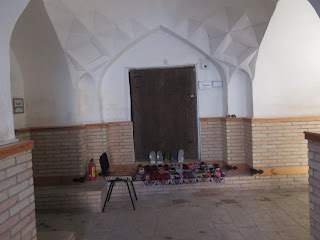








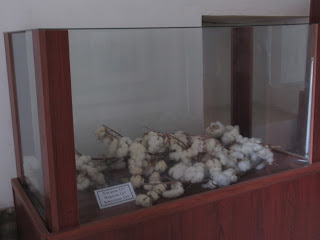







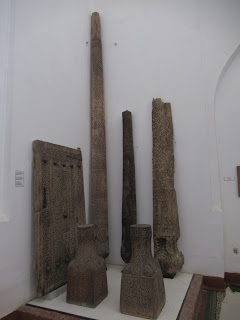









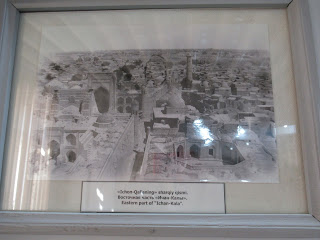
















































































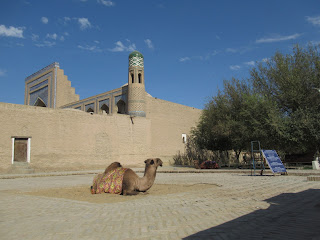























Bravo to Steve ....GORGEOUS photos of you dear Annie as the sun set !! Loved the intricate tile work, the impressive "forest" of wooden pillars in the Friday Mosque, the noted serenity of the presence of a higher power and the wedding photographer on his segway. xoxox
ReplyDeleteLina, What a boon you are to comment on the photos Steven took of me at sunset - I was just lucky with the perfect light and picture perfect background! Miss you.
ReplyDeleteI sure was an UGLY sheep. But, sunset was magical. Lil Red
ReplyDelete